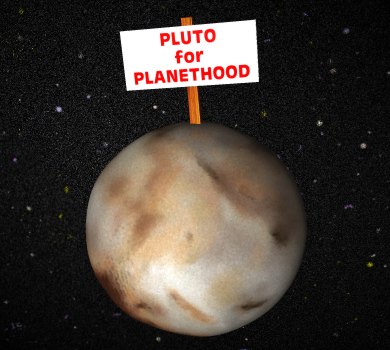For those of you who are not familiar Cameron Smith's
The Top Ten Myths About Evolution, it is an excellent book. Like the best works of popular science, it guides the reader without expecting them to already know anything about the subject. While its main purpose is to rebut the most popular misconceptions about the theory of evolution, it also teaches the science needed to fill the void that abandoning creationism leaves.
In this post, I am going to provide my own rebuttals to Cameron's "top ten myths." The reason why I am doing this is because I want a succinct and easy to read list available for linking. I believe that lots of people are on the fence about evolution not because they embrace creationism, but because they simply are unaware of the facts behind the science (the only exception to this is that I changed number 2). If you read this list and desire to know more, I recommend that you purchase Dr. Smith's book.
1: Survival of the fittest.
A common misunderstanding about evolution is that "survival of the fittest" means only the strong and ruthless survive. This is wrong. What Herbert Spencer and Charles Darwin meant by "survival" is merely an organism's success rate at passing on copies of its genes into the future through reproduction. They also meant something entirely different by "fittest" than most people think. Instead of meaning an individual's ability to dominate others, they meant organisms who are better adapted for their immediate, local environment. Taken together "survival of the fittest" means: the organisms which are the most likely to pass on copies of their genes to future generations are those who are better adapted to their immediate, local environment (a definition I borrowed from philosopher of biology, Alexander Rosenberg).
It should also be noted that many of the best strategies for passing on ones genes often have nothing to do with strength or ruthlessness. Many animals, such as various kinds of octopuses, bugs, and birds, use evasion techniques like camouflage and mimicry to successfully ward off predators and gather food undetected. Other animals, like certain large mammals and bats, use group cooperation and food sharing to ensure their survival. These strategies have been very successful at ensuring the propagation of species and are the reason why humans are still around. They are also probably the reason why humans feel empathy and compassion towards others.
2: There is no proof/just a theory
A common trope which is just as popular is that there is no evidence for evolution. This misconception, however, has little to do with science and a lot to do with how bad schools are in the USA. Evolution is actually one of the most studied, successful, and supported theories in all of the sciences. The evidence which supports it flows in from all branches of biology including genetics, homology, paleontology, embryology, and study of the geographical distribution of animals. If you are curious about this evidence, then you can read through
Talk Origin's guide to the subject or watch Neil Shubin's documentary
Your Inner Fish. The thing I recommend doing the most is reading through Jerry Coyne's
Why Evolution is True and Richard Dawkins'
The Greatest Show on Earth. They are both excellent popular level books which explain this evidence.
To see why the "
its only a theory" objection is flawed, you need to understand what scientists mean by "theory." Rather than meaning "a hunch or guess" (like in everyday speech), scientists mean something like "a testable and well-confirmed explanation which organizes data and yields fruitful predictions." This is why the existence of atoms is explained in atomic theory and the fact that some diseases are caused by microorganisms like bacteria and viruses is explained in germ theory. If you take introductory science classes in college, such as biology, geology, or astronomy, your professor will almost certainly cover this distinction in the introductory unit on the nature of science.
3: The ladder of progress
Many people believe that evolution means that all living things are improving towards a perfect state. This is usually envisioned as a ladder with man at the top striving towards godhood with all other living things occupying lower spots on the ladder and striving to be like man. These lower living things are ranked and given their spot on the ladder based on how similar to man they are. The more like man they are in appearance, the higher their ranking is on the ladder. This idea, however, is dead wrong. Living things are not striving towards being more like man and, as we discussed in misconception #1, fitness is only about passing genes on, not becoming more like man.
In many instances, being less like man is a better survival strategy. For example, many mammals like dolphins evolved from land animals. They, however, lost their limbs and returned to the water. This "regression" has worked out well for them and they are one of the most vicious predators in the ocean. If the ladder theory was true, then dolphins should have become more like man through evolution, not less. Other organisms, like the great white shark, are also good counterexamples because they have barely changed since the time of the dinosaurs.
4: The missing link
It is a popular belief that there is a missing link between man and apes and this absence is a reason for doubting the cogency of evolution. This criticism, however, misunderstands man's relationship to the other apes (chimps, bonobos, gorillas, gibbons, and orangutans). Evolutionists do not think we "came from" any one of these animals. Instead they think we share common ancestors with them. These ancestors, such as the one we share with chimps, would be just as genetically different from chimps as it would be from us. This idea can be understood by the family analogy. Just like we share a common ancestor with our cousin (our grandparents), we share a common ancestor with chimps. For our more distant, second cousins (such as gorillas), you have to go back a further generation to great grandparents.
While the fossil record will always be incomplete because only a fraction of one percent of dead organisms fossilize, there is an absolute ton of amazing fossils left over from this branching process and I highly recommend reading up on them (message me and I will recommend some books). The evidence for common ancestry, however, comes from much more than paleontology. The fields of genetics, embryology, bio-geography, and comparative anatomy converge to attest to human beings sharing a common ancestor with apes (read about this evidence
here and
here).
5: Evolution is random
It is certainly true that one of the two pillars of evolution is random mutation. If you are unfamiliar with random mutation, it simply refers to the fact that when genes are passed on to the next generation, they are not copied perfectly. These tiny differences usually do nothing, but sometimes they make the offspring slightly faster or slightly better a camouflaging themselves. These modifications accumulate overtime as genes are inherited from generation to generation (they do not "start over," which is every important).
Natural selection, which is the second pillar of evolution, favors those organisms which have those slight advantages. As generations pass and the fastest and best camouflaged organisms survive longer and have more offspring, the species as a whole will change. For example, suppose we have a population of mice living in an environment where being brown is a massive advantage. The browner mice will live longer than their less brown relatives. Their even browner offspring also will tend to survive longer and have more babies than their less brown siblings. As this pattern of survival by being brown proliferates over time, the mice population will become increasingly brown. This is how natural (non random) selection interacts with accumulated random mutations to drive evolution.
6: People come from monkeys
As I talked about in #4 and in my
criticism of Katt Williams, people did not come from modern day monkeys. Instead, we share a common ancestor with them. This misconception is one of the major reasons why people expect there to be a "missing link." It should also be said that the reason that monkeys are not turning into people (as discussed in #3) is that evolution is not a directed process of being more manlike. The "goal" of monkeys is not to become man, but to simply pass on their genes.
7: Nature's perfect balance
Nature is usually believed to be a harmonious whole which is in perfect balance. On the environmental level, however, this is false. The environment is in constant flux from external factors (meteors, etc...) and internal factors (the gradual moving of tectonic plates, the accumulation of certain gases in the atmosphere). These changes move the survival goalposts and force organisms to come up with new adaptations or perish.
As #5 points out, random mutation also means organisms slowly change. As small modifications accumulate in a lineage, organisms gain new abilities which are then selected for or against by their environment. This is quite different from how creationists think about animals. Unlike biologists, they believe that "dogs stay dogs (this is ironic because humans selectively bred dogs from wolves)" and "cats stay cats (again, ironic)."
8: Creationism disproves evolution
No it doesn't. The evidence for evolution is overwhelming (see no, 4) and the evidence for creationism is non-existent. If anything, evolution disproves the versions of creationism that are incompatible with it. If you would like to see point by point rebuttals of creationist arguments that are not included in this post, please visit
Talk Origins.
9: Intelligent Design is science
Intelligent Design is not a coherent theory, just creationism in a lab coat. To quote Paul Nelson:
Easily the biggest challenge facing the ID community is to develop a
full-fledged theory of biological design. We don’t have such a theory
right now, and that’s a problem. Without a theory, it’s very hard to
know where to direct your research focus. Right now, we’ve got a bag of
powerful intuitions, and a handful of notions such as ‘irreducible
complexity’ and ‘specified complexity’-but, as yet, no general theory of
biological design.
Unlike IDC, evolution is a full fledged theory. We can say this because it unifies all areas of modern biology into a coherent framework, makes novel predictions, is ontologically parsimonious (it appeals to no entities outside of the natural world), and has great explanatory scope. IDC has none of these virtues.
As it has been
shown conclusively, IDC is merely a strategy designed by creationists following the disastrous
Edwards vs. Aguillard ruling. Since it was clear following this court case that creationism was not going to be able to get past the First Amendment of the United States Constitution, creationists got rid of the explicit appeals to Biblical literalism and recruited several very bright scholars like Michael Behe, William Dembski, and Stephen Meyers. The end result was Intelligent Design.
10: Evolution is immoral
This idea could be taken two different ways. The first is that natural selection favors those organisms which are selfish and backstabbing. This means that it literally breeds for traits that are immoral. As I said in #1, however, many organisms have survived due to strategies like sharing food and protecting one another. Bats, for example, share with their brethren who did not successfully acquire food. Likewise, bats who do not share become pariahs and their brethren will not help them if they are unsuccessful a following night. Human beings have evolved a very strong moral sense. Despite popular conceptions, the overwhelming number of human interactions are cooperative (see Jessica Piece's
Wild Justice for lots of well developed information about this subject). .
The second interpretation of this claim is that if evolution is true, there can be no ultimate grounds for morality. While some very respected philosophers like Richard Joyce, Alexander Rosenberg, and (the late) JL Mackie believe this, many ethicist think that biology has no adverse effect on morality. Since Ancient Greece, philosophers have been doing morality without any appeal to the supernatural. These scholars charge that biology effects their ethical ideas in a positive way by illuminating how the world works. This, they argue, allows them to more effectively bring about what they think ought to be the case. If you want to explore morality more, I recommend Peter Singer, (the late) Philipa Foot, Simon Blackburn, and Philip Kitcher. They all have very different, but very interesting, things to say.
Conclusion
I hope that this post helps you explain and elucidate the wonders of science. If you would like more tools in this fight, please click on my content section. There I have posts about how to talk to non-skeptics and other responses to creationism. You can also do, as I mentioned earlier, purchase Dr, Smith's excellent book.










.jpg)


